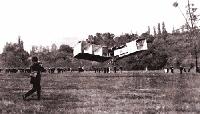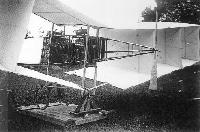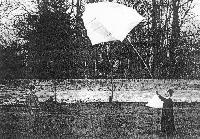
Описание
Страна: Франция
Год: 1906
A.Andrews. The Flying Machine: Its Evolution through the Ages (Putnam)
The joiliest of all the daring young men whose career spanned the birth of flight was Alberto Santos-Dumont. He was the son of a wealthy Brazilian coffee planter, on whose vast estate Santos was driving railway engines at the age of 10. He came to Paris in 1891, when he was 18, to study the development of the automobile. But he swiftly developed a passion for aeronautics and, as inventor and patron, he was an inspiring pioneer of flight in machines both lighter and heavier than air. He first took up ballooning in 1897, and went on to build airships. He was the first to put the internal combustion engine into the air as a practical instrument. By 1901, at the age of 28, he had won fame and the then gigantic prize of 125,000 francs by navigating his Airship No 6 from Saint-Cloud, around the Eiffel Tower, and back again - the first really guided flight by air. Santos-Dumont captured the affections of the Parisians by flying his airship very low (and quietly) down the Paris boulevards, and surprising strollers by unexpectedly joining in their conversation as he passed them from the rear. He used to tie his airship up at his country club as a cowboy would hitch his horse to a rail.
Santos-Dumont subsequently went to America, learned from Chanute of the achievement of the Wrights, and enthusiastically came back to France to concentrate on heavier-than-air flying. He built his famous 14-bis canard-type cellular biplane, which he first tested from an overhead wire rope ineffectively pulled by a trotting donkey, and later (see illustration, p. 108) suspended from his Airship No 14. In free flight in this machine he first hopped 60m on 23 October 1906, and later 220m in 21-2 seconds on 12 November 1906, and won the prize offered by the Aero-Club 'de France for the first heavier-than-air machine to fly for over 100m.
Описание:
- A.Andrews. The Flying Machine: Its Evolution through the Ages (Putnam)
- L.Opdyke French Aeroplanes Before the Great War (Schiffer)
- Журнал Flight
Фотографии
-
G.Loening - Takeoff into Greatness /Putnam/
Almost three years after the Wrights' first flight, Santos-Dumont in France managed to get this machine off the ground for a short flight of 82 feet. He was hailed in Europe as the first successful aviator.
-
Jane's All The World Aircraft 1913 /Jane's/
1906 Santos-Dumont 14-BIS - made first powered flight in Europe
Country of origin: France/Brazil. Designer: Alberto Santos-Dumont, Brazilian living in France.
Span: 38'9", Length: 31'10" Weight: 661 lbs -
A.Andrews - The Flying Maschine: Its Evolution through the Ages /Putnam/
Alberto Santos-Dumont’s 14-bis in flight on 23 October 1906, the first considerable and witnessed aeroplane flight in Europe. The machine, which is going from left to right in the picture, had pronounced dihedral box-kite wings with an area of 52sq m. A 25hp Antoinette engine originally drove a 2 1/2 m diameter pusher propeller at 900rpm, but for this, its second free flight, a 50hp Antoinette was substituted. The forward box-elevator pivoted vertically. Santos-Dumont is standing in a wicker basket and he is wearing a body-harness which in the following month he adapted to control octagonal ailerons between the wing-tips, leaning to right or left to establish some lateral control. In this finally-modified 14-bis he made a record flight of 220m, but crashed the next time he took the machine up. That was the end of the 14-bis - typical of the short life of aircraft types in the 1900s.
-
P.Hare - Royal Aircraft Factory /Putnam/
Santos-Dumont made the first powered flights in Europe in his 14bis canard boxkite biplane in October 1906, but it was dead-end design and its 'flights' were nothing more than brief hop-flights that paled into insignificance when compared with the extended, fully controlled flights already achieved by the Wrights.
-
L.Opdyke - French Aeroplanes Before the Great War /Schiffer/
A real photograph of the No I4bis in flight.
-
L.Opdyke - French Aeroplanes Before the Great War /Schiffer/
Moving the Santos-Dumont 14bis very carefully through a gate, Alberto Santos-Dumont himself leading the way.
-
L.Opdyke - French Aeroplanes Before the Great War /Schiffer/
A close-up of the aft end of No 14bis, the pilot to stand upright at the control wheel at the left.
-
L.Opdyke - French Aeroplanes Before the Great War /Schiffer/
Santos-Dumont and his mechanic and their model, 1905.
-
Журнал - Flight за 1913 г.
Santos Dumont's tall-first biplane, with which he won the first flight prize on October 23rd, 1906, by flying a distance exceeding 25 metres.









